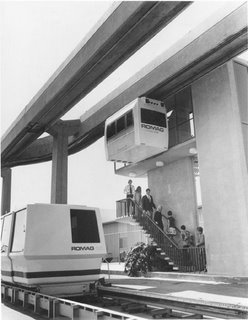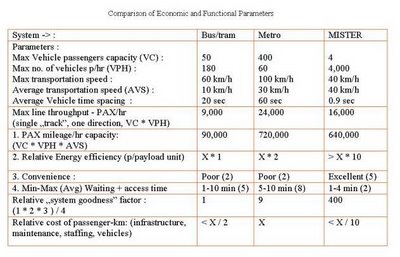PRT Presentation in Ottawa

Ottawa is the largest geographically city in Canada.
To build roads network in such city a lot of time and money is required.
97% of trips in North America are made by car.
Car is the right size, just the wrong mass and randomness of behaviour.
PRT is a technology developed in 1960s.
1970s, West Virginia University constructed a PRT system with 8.7 miles of roadway and 5 stations for 126 million USD, about 319 million USD today adjusted for inflation. This figure of about 89 million USD per-route mile
In 1990 PRT was proposed in Illinois, 3.5 mile triple-looping layout with about 8 stations and 40 cars. In 1998, however, problems began to surface as costs began to soar above the initial estimates of USD 23 million/mile.
Since then many different countries assign limited funds to do analysis, feasibility study, ergonomic, reliability and many other tests, but no one so
 far decided to run it, even though all results are amazing.
far decided to run it, even though all results are amazing.Albert Charlier had built the "schwebe bicycle" in 1895.
There are different approaches to this technology and some of them are already applied in countries such as Australia, US, Germany, England and few others.
However, all these systems work more like APM (automatic people mover) not as a PRT.
At this moment no finished and working PRT system exists on the World, but such system is presently build in 6 places around the World.
At London's Heathrow Airport, starting in summer of 2008, 19-computer steered electric cars will go into operation. The automated taxis will be used to connect Heathrow's Terminal 5 with a parking lot. The technology, which has been named "ULTra," has been developed by the British firm ATS and is already being tested. The driverless vehicles pick up passengers after they are ordered and deliver them to their destination. Magnets or sensors on the ground direct the vehicles along their route
Here is a short description of driverless projects which will be implemented in Rome, Italy and in Castellón, Spain.
In Rome, special driverless 'cybercars' will take visitors between a new exhibition centre, the car park and nearby railway station. In Castellón, special buses that can run either with or without a driver, depending on the traffic conditions, will operate in the town centre.
And as writes the Spiegel, "that's only the beginning." Sources: Spiegel Online, September 7, 2006.
PRT is like car, can take us whenever and wherever we want.
This is in the nature of a network exactly like emails.
The real value PRT is that they are inexpensive enough to build networks. Point-to-point.
For 1 km of multilevel intersection we can build 20 km of PRT
Cost of 1 km metro equal to 12 km PRT
Cost of 1 km LRT or 1 km of 6 lane H-wy equal to 6 km of PRT

Did you ever ride a rollercoaster?
So you know how PRT works, just with a better comfort, safer, and much slower.
Instead of moving 45 tons (empty) LRT we move only people.
Instead of using huge kinetic energy 20 times (each station) we use small kinetic energy and only once.
One PRT cabin requires the same energy as your home hair dryer.
We can save 80% energy on transportation.
One-rail railway car can take curves with a radius as small as 8 meters, while ordinary double railway cars cannot handle curves with less than 250 meters' radius.
There are 2 different mono-rail types of PRT.
One of them is on top and another is below the track, known as suspended.
I will concentrate only at suspended solutions, that using gravity force always keep vertical position, reduces winter road maintenance and cleaning expenses.
It is proofed that suspended system is the safest on the world.
In Germany, suspended Wuppertall system exists 105 years, commuted 1.6 billion people and had only one accident (human error) where 5 people died.
Rollercoaster technology is proven and is 9000 times safer than cars. There were in total 34 deaths in 26 years rollercoaster history.
Comparing to the car, in America there are 14 deaths for every 100 000 cars, in Ottawa we have had more than 30 traffic deaths a year.
Presently we have 3 different designs of suspended PRT technology:
JPODS Minnesota, MISTER in Poland, and SkyTrain in California.
I have called all 3 designers and presently I have close contact with them.
Two first uses wheels/rolls and electric engine, where the third one uses only magnetic field to hold and move the cabin (none movable parts). Solar battery and braking to retract the energy can be used.

In March 6, 1971. A ROMAG test vehicle was successfully tested. It was the first time in the U.S. that a person rode a vehicle supported and moved by magnetic forces (neither wheels nor electric engine was used).
In my possession is video 34 years old showing suspended system working between 2 hospitals. It was build in 1972 in Germany and still is used to transport patients and personnel, to deliver food and medicine. It uses simple electric motor.
What these PRTs have common is that all are suspended, use electricity, computers, wireless communication, are cheap, safe, and fast to build without traffic interruption. In opposition to the others public transportation methods, the PRT is profitable.
There are no major technical problems with PRT, but it social, economical, and political implications are too great to predict.
My proposition for Ottawa is to make a very small PRT project as a city attraction for tourists, students and pedestrians in the downtown core. This investment will return to the investor in max 2 years. I would first connect a few main and famous places in town such as the War Museum, Spark St., Ridau Canal, Market, Civilization Museum, Casino de Hull, or connect both Universities. This tiny project, working in a real environment will proof that this is a right technology. For the pessimists, if this system would require additional time for adjustment or even modification because of diverse climate conditions, there will be not a problem to stop its operation for few days. Later on, when all of us will see just advantage of it, we can expand PRT network without stopping its operation, simply adding a stations and tracks going deeper in entire city (building 30-40 km./year).
It will deliver more people closer to their destination for smaller fees, much cheaper than LRT, can be extended or removed any time very easy and fast.
Having alternative in PRT many seniors would leave their houses, drunk drivers will disappear from our streets and we all will have another chance marketing Ottawa as a technology center.
Ottawa missed the chance “to make itself visible as a city at the forefront of technology.
Ottawans, Lets Do It, Give Job to Canadians and do not miss again the chance making Ottawa visible as a city at the forefront of technology.

I invite all Ottawans to PRT Open House, where they would be able to see and ride on a real scale JPODS model suspended on the track. In the middle of October Mr. Bill James from Minnesota will bring his prototype to Ottawa.
Now I like to plant PRT in your imagination.
Low capitol cost • Low operating cost • No waiting • No Pollution • No Noise • Non-stop journeys • Guaranteed journey times • Unobtrusive guide ways • Extendable without service interruption • Safety critical automatic control system • Small-scale off-line stations • 4+ seater vehicles - air conditioned or heated• Segregated elevated guide ways • Travel with companions of your choice • Direct from origin to destination.
The money city will invest in this project will be invested in project it self, research groups, Ottawa’s Universities, engineering and architectural offices here in Ottawa. All contractor will be local as well. If we act quickly, we can create a lot of jobs in Ottawa.
We are approaching economic and environmental cul-de-suc.
The ethic should not let us think only about our selves and only about today.
We have to sacrifice today to benefit the future.
The need in for individual transit, there are 1.08 people per car in rush hour(s).
The average American worker loses a workweek per year to congestion.
5 billion gallons of gas are wasted yearly in congestion (ASCE).
Rush hour gets longer and slower every year.
Since 2000 price of oil tripled, every year we lose 5% of oil and experts predict that in 2009 a gallon of gas will cost USD 9.
Our society cannot afford to pay $2/liter of gas to get to work.
Each time a hurricane or terrorist’s attack happens, we are afraid that our economy will collapse.
It is important today to know how our kids will get to work in the future and be not oil dependent.












